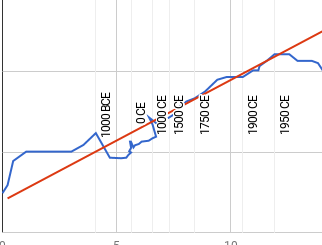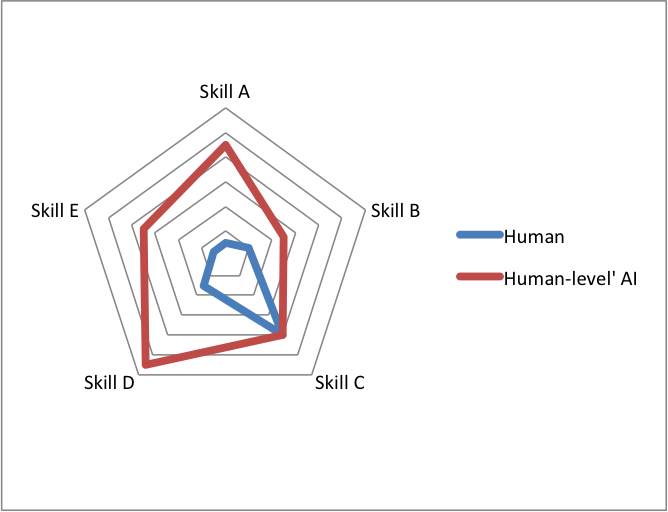The human brain’s approximately 86 billion neurons are probably connected by something like 850,000 km of axons and dendrites. Of this total, roughly 80% is short-range, local connections (averaging 680 microns in length), and approximately 20% is long-range, global connections in the form of myelinated fibers (likely averaging several centimeters in length).
Background
The brain’s precisely coordinated action relies on a dense network of fibers capable of rapidly transmitting information, both locally (to adjacent neurons whose separation can be measured in microns) and to distant locations removed by many centimeters from one another. And while manipulation of that information–”computation”–is an important component of what the brain does, it would be hard-pressed to make any use of that computational power without the ability to communicate within itself.
So how much of a problem does the need for moving around information pose for brains and, by extension, brain-like computers? It’s clear from a cursory physical examination of the brain that evolution has prioritized information transfer, since the vast majority of brain tissue is taken up by the tendrils of axons and dendrites snaking through a convoluted maze of cables. Some proportion of these form short-range connections with neurons that are both nearby in physical space, and are probably also close in “functional space” as well. The rest are long-range fibers, which move information from these local, functionally similar regions to areas separated by significant physical, and likely also functional, distance. Whether we can expect one type of connection or the other to impose a larger cost on hardware, as well as the transferability of total brain fiber length to communication requirements in hardware, depends largely on the kind of hardware in question. One can imagine both types of brain-mimicking computer architecture that might make long-distance communication the main limiting factor, as well as architectures where long-distance communication was trivial compared to short-distance communication.
AI Impacts previously estimated brain communication costs in terms of the benchmark TEPS, or “traversed edges per second”, where “edges” corresponded roughly to synaptic connections between neurons. However, this benchmark measures performance in a certain family of graphs that may not be very representative of connectivity patterns in the brain. Characterizing the actual topology of connections in the brain, especially the proportions contributed by long and short fibers, may give us a more informative picture of the capacities hardware will need in order to mimic wetware.
Short fibers
Our estimates for length and length distribution of short fibers were found by comparing the results of what might be called “top-down” and “bottom-up” approaches. Directly measuring any cell-level metric for the entire brain is challenging, but two substantially different methodologies converging on similar answers is probably a reasonable substitute for direct measurement. The first of these relied on observations of fiber density in the neocortex of rats, which there is reason to believe translates fairly well to the human brain as a whole. The second required gathering morphology data on various types of human neurons, then adjusting for the proportion of each cell type in the brain.
Some important notes on brain structure and animal models
In this section, our estimates were drawn from only two brain regions: the cerebral cortex alone in the first case, and the cerebral cortex and cerebellar cortex in the second. However, taken together, these regions account for roughly 85% of total brain volume and as many as 99% of all brain neurons in humans, making this a safe approximation for all gray matter (which represents short connections–see here) in the brain.
Since the first case considers the brains of rats rather than humans, it may seem to have little utility, but in fact the composition of tissue in rats’ neocortex differs from ours in only a few predictable ways. There are more neurons per cubic millimeter in the cortex of small animals (3-10x), meaning that somewhat more of the brain’s volume is taken up by cell bodies, slightly decreasing the density of fibers compared to larger brains. However, cell bodies are measured in the tens of microns, so this is unlikely to bear on our conclusions.
Total length from neocortical fiber density
While the cerebral cortex comprises 82% of the volume of the human brain, only 19% of the brain’s 86 billion neurons reside here, cushioned in the dense web of axons and dendrites known as “neuropil”. The amount of neuropil packed into any given tissue sample can give us a sense of the lengths of these fibers per unit volume, as long as we also know their diameters.
After determining rat neocortical fiber density, Braitenberg and Schüz (1998) concluded that the total length of the average neuron’s axonal tree was between 10 and 40 mm, and that the average dendritic tree came out to 4 mm. These numbers were derived from examining electron micrographs of tissue samples to find the proportion of area taken up by axons and dendrites, then measuring the average diameter of these fibers to find an axonal density of 4 km per mm^3, and a dendritic density of 456 m per mm^3. It’s not quite clear to us how the authors got from these numbers to average fiber length per neuron, but since their average values agreed with values we obtained by other methods (see below), we were inclined to assume their process was reasonable.
Assuming mouse neocortical neurons are comparable to human neurons, their average fiber length suggests that the neocortex alone contains at least 220,000 km of short range connections between dendrites and axons.1
Total length and distribution of lengths from morphological data
In principle, obtaining estimates of average fiber lengths from a representative sample of different varieties of neuron should yield something close to the sum total fiber length for all brain neurons, when combined with information about the neuronal composition of the brain.
Granule cells
The most numerous neuron type in the brain is the cerebellar granule cell, at around 50 billion (58% of the brain’s total neurons). These small cells have three to five unbranched dendrites, each around 15 microns long and appended by a “claw”. They’re primarily distinguished by their unusual axonal morphology, which extends from the lowest of the three cerebellar cortex layers to the outermost layer, then splits perpendicularly into two fibers, forming a “T”. The fibers forming the top of this “T” run an average of 6 mm total, and while it was difficult to find a direct measurement for the other axonal component, the number is bounded by the thickness of the cerebellar cortex at 1176 microns, and is probably much shorter on average. Overall, the fiber length of the average cerebellar granule cell is probably in the neighborhood of 6.6 mm, giving us around 330,000 km in total.2
Pyramidal cells
The next most numerous neuron type, at around 2/3rds to 85% of the cerebral cortex (or 10.5-13.6 billion cells in humans), is the well-studied pyramidal cell. Pyramidal cells are in close contact with their neighbors in the vertical direction, forming tiny “columns” along the cerebral cortex that are thought to have functional relevance, with relatively less connectivity between columns. This is reflected in the structure of the pyramidal cell’s dendritic tree, with a long fiber extending vertically from the cell body (the apical dendrite) and several relatively short fibers branching laterally (the basal dendrites). Some pyramidal cells have long, myelinated axons that connect the two hemispheres or different functional areas of the same hemisphere, and these axons will be considered in the next section on long fibers, but for now we will focus exclusively on more local connections.
Quantitative descriptions of pyramidal cell morphology were lacking, so we collected data on 2130 human pyramidal neurons from the NeuroMorpho.org database, computing various metrics for each neuron using L-Measure, and then performed our analysis with R (data here).
Dendritic trees had an average total length of 3.4 mm per cell, with a standard deviation of 1.8 mm. We also analyzed path distance, or the length between the terminal point of one branch and the soma. The average path distance of pyramidal dendrites’ longest branch was 340 microns, which likely corresponds to the apical dendrites, while a typical branch was 180 microns. Axons were vastly less well represented in our dataset–only 243 had nonzero values, and while the mean length for these axons was in the same ballpark as the estimate found by Braitenberg and Schüz, at 11.5 mm, it’s probable that not all axons in the dataset were complete.3 In particular, the length distribution was bimodal, with maxima around 100 microns and 20 mm, and this latter number may be the more accurate. This bimodal distribution was also reflected in the path distance of axonal branches, with (what we suspect to be) the more realistic values around 2.2 mm average for each neuron, and 4 mm for the longest branches. In all, pyramidal cells as measured here probably contribute roughly 23 mm each to the brain’s fiber network, or ~240,000 to ~310,000 km, in basic agreement with the numbers obtained from neocortical fiber density.4
Other cell types
The remaining cell types made up a much smaller proportion of total fiber length. Besides pyramidal neurons, stellate cells are the other primary residents of the cerebrum, and are known to be substantially smaller than their cortical comrades, with axonal projections no longer than their dendrites. They could therefore add no more than 9,600-22,000 km to the total.5 After the 50 billion granule cells, the cerebellum still has 13-20 billion neurons to account for, over half of which are small stellate cells, a quarter basket cells, and the remainder split evenly between Purkinje cells and Golgi cells. Between them, these cerebral and cerebellar cells probably contribute 65,000 to 110,000 km.6
Long fibers
Myelination as indicative of fiber length
The most natural point of transition from “short range” to “long range” is the length of fiber for which conduction velocity of action potentials in a bare axon becomes unacceptably slow. Rather conveniently, this demarcation is evident from a glance at a cross section of the brain, where the white of myelinated fibers stands in stark contrast to the gray matter.
Fatty insulating sheaths of myelin are used by the brain’s longest fibers to increase conduction velocity at the cost of taking up more volume in the brain, as well as rendering myelinated segments of axons unable to synapse onto nearby neurons. Frequently, axons running through white matter tracts bundle with others inside a single myelin sheath, a frugal move for a brain with space and energy constraints. It’s unlikely that in these circumstances a brain would expend resources to myelinate short connections with no great need for it, so it’s reasonable to assume that all myelinated fibers are long. Furthermore, gray and white matter are highly segregated, and myelin is rarely found in cortical tissue.
Length of myelinated fibers from white matter volume
This protective myelin coating not only insulates axons from lost transmission, but also, unfortunately, from the prying eyes of scientists. This means that long distance connections are difficult to study, and there have been few attempts to characterize white matter fibers at an appropriate level of detail for our purposes.
One frequently cited figure comes from Marner et al 2003, where the method called for divvying up preserved brains into slabs and take needle biopsies from random points on the slabs, then slicing these biopsies into fine sections and staining them. These could then be inspected for dark colored rings corresponding to myelin sheaths, and the total length of fibers could be approximated by multiplying “length density”, or total length of fibers per volume of white matter, with white matter volume. This method yielded a total of 149,000 km of myelinated fibers in female brains, and 176,000 km in males.
As for the distribution of these fiber lengths in the brain, we’re left somewhat in the dark. A very imprecise estimate for a portion of them can be gotten from a few key facts about the cerebrum. The largest and most famous white matter tract in the human brain is the corpus callosum, which connects the two hemispheres and contains 200-250 million fibers, about as many as one can find in tracts connecting areas within hemispheres. Given the width of the corpus callosum (~100 mm, or two thirds of the brain’s total width), a reasonable value for average fiber length in this tract is 10 cm, suggesting that perhaps 50,000 km or less of long-range fiber connects the cerebrum with itself.7 Clearly, this leaves much white matter to be accounted for, which can presumably be attributed to connections within and between the cerebellum and subcortical structures, as well as the occasional cerebral white matter found outside the white matter tracts.
This vague picture can be supplemented by the relationship between long-range connection length and brain volume alluded to in Wen and Chklovskii 2004. These authors estimate that average global connection length should be roughly similar to the cube root of brain volume, or 10.6 cm – 11.4 cm, much like the figure we approximated above for intracortical connections.
Discussion
Summary of conclusions
Our estimates are aggregated in the table below:
| Connection type | Total length (km) | Average length per neuron (mm) | Contributing neuron types | Sources of evidence |
|---|---|---|---|---|
| Cerebral, short-range | 220,000 - 320,0009 | 14 - 20 | Pyramidal (2/3rds to 85%), stellate | Fiber density in rats, morphometry |
| Cerebellar, short-range | 390,000 - 420,0008 | 5.7 - 6.1 | Granule (~70%), stellate, basket, Purkinje, Golgi | Morphometry |
| Total, short-range | 610,000 - 740,000 | - | - | - |
| Cerebral, long-range | ~50,000 | 100 | Pyramidal | Width of corpus callosum, relationship between brain volume and global connection length |
| Total, long-range | 150,000 - 180,000 | ? | ? | Length density per white matter volume |
| Total, all fibers | 760,000 - 920,000 | - | - | - |
Overall, we’re somewhat less confident in our total for long-range fiber length than our other estimates, since this was obtained using a methodology whose reliability we’re not able to judge, and its findings couldn’t be directly corroborated with other methods. However, there is indirect evidence that these numbers will hold up reasonably well: the proportion of total cerebral wiring that cerebral long-distance connections account for (14%) is quite similar to the proportion that long-distance connections purportedly account for overall (20%), despite the former number coming from independent lines of evidence.
Implications and future directions
The brain is the most metabolically expensive organ in the human body by volume, and has pushed the limits of natural birth by increasing the pelvic width of human females, via enlarged infant head sizes, to the edge of feasibility for walking. The massive resource requirements of the brain are clear, but the proportion demanded by communication (versus computation) is less clear.
Costs to the brain can be expressed in terms of space, energy (for development, maintenance and operation), and the difficulty or error-proneness of orchestrating complex activities. Space may be the cost most strongly influenced by brain wiring, and can easily be predicted to translate to computers, but the amount brain wiring also contributes to energy costs. In computers, this will take the form of operation energy, or the power needed to send “action potentials” along connections.
By themselves, our estimates of fiber lengths in the brain won’t answer any questions about the difficulty of communication in computers broadly. However, they can be informative when considering a specific hardware architecture, and are likely to be especially so in the case of massively parallel architectures. Combining our estimates with other estimates relating to information transfer in the brain, like information density, may also yield insights relevant to AI hardware.
Contributions
Research, analysis and writing were done by Tegan McCaslin. Katja Grace contributed feedback and editing. Paul Christiano proposed the question and provided guidance on hardware-related matters.
Footnotes
- 16 billion neocortical neurons x (minimum total axonal length per neuron (10 mm) + total dendritic length per neuron (4mm))
- 50 billion cerebellar granule cells x (total parallel fiber length per neuron (6 mm) + other axonal component length per neuron (~0.6 mm) + total dendritic length per neuron (0.045 mm))
- This data set was coded to specify the integrity of cell compartments (dendrites, soma, axon), and a very high proportion of axons were coded as incomplete. However, this coding was not reliable enough to filter the data effectively, so all non-zero axons were included in the first pass analysis.
- Number of pyramidal cells (10.5 to 13.6 billion) x (total dendritic length per neuron (~3 mm) + total axonal length per neuron (~20 mm))
- Number of stellate cells (2.4 to 5.5 billion) x (estimated total dendritic and axonal length per neuron (4mm))
- Total length of cerebellar stellate cells (8.5 to 13 billion cells x 4 mm) + total length of basket cells (3.25 billion to 5 billion cells x ~4 mm) + total length of Purkinje cells (0.6 to 1 billion cells x ~10 mm) + total length of Golgi cells (0.6 to 1 billion cells x ~4 mm) + total length of cerebral stellate cells (see previous footnote); Note that length estimations preceded by a tilde are a rough guess based on the size of the neuron. Because these cells were so few in number, a high degree of precision was not expected to improve our overall estimate very much.
- (250 million callosal fibers + 250 million intrahemispheric fibers) x axon length (~10 cm)



5 Trackbacks / Pingbacks
Comments are closed.